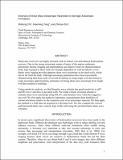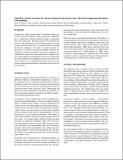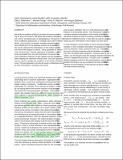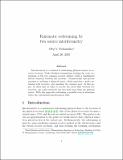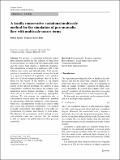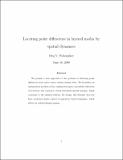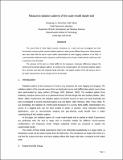Browsing Earth Resources Laboratory by Title
Now showing items 247-266 of 456
-
Inversion For Permeability From Stoneley Wave Velocity And Attenuation
(Massachusetts Institute of Technology. Earth Resources Laboratory, 1990)The in situ permeability of a formation is obtained by the inversion of Stoneley wave phase velocity and attenuation, which are evaluated by applying the Extended Prony's method to the array sonic logging data. The Maximum ... -
Inversion of Borehole Guided Wave Amplitudes for Formation Shear Wave Attenuation Values
(Massachusetts Institute of Technology. Earth Resources Laboratory, 1987)A linear least squares inversion, based on analytic partition coefficient expressions, is developed to estimate the fluid and formation shear wave Q values from spectral ratio measurements-of the guided wave arrivals of ... -
Inversion of Shear Wave Anisotropic Parameters in Strongly Anisotropic Formations
(Massachusetts Institute of Technology. Earth Resources Laboratory, 2006)Deepwater reservoirs use highly deviated wells to reduce cost and enhance hydrocarbon recovery. Due to the strong anisotropic nature of many of the marine sediments, anisotropic seismic imaging and interpretation can improve ... -
Inversion Of Travel Time For Velocity
(Massachusetts Institute of Technology. Earth Resources Laboratory, 1983)Common source velocities and borehole compensated (BC) estimates have been used to obtain formation velocity estimates from full waveform acoustic logs (Willis and Toksoz, 1982). With both of these methods the ... -
Inversion of Travel Time for Velocity Using Multi-Spacing Sonic Tools
(Massachusetts Institute of Technology. Earth Resources Laboratory, 1985)Spatial resolution of sonic logs is greatly affected by the minimum spacing between receivers. Improvements can be made, however, when the spatial sampling of the formation is less than the minimum spacing. This paper ... -
Joint flow-seismic inversion for characterizing fractured reservoirs: theoretical approach and numerical modeling
(Massachusetts Institute of Technology. Earth Resources Laboratory, 2013)Traditionally, seismic interpretation is performed without any account of the flow behavior. Here, we present a methodology to characterize fractured geologic media by integrating flow and seismic data. The key element of ... -
Joint microseismic event location with uncertain velocity
(Massachusetts Institute of Technology. Earth Resources Laboratory, 2013)We study the problem of the joint location of seismic events using an array of receivers. We show that locating multiple seismic events simultaneously is advantageous compared to the more traditional approaches of locating ... -
Kinematic redatuming by two source interferometry
(Massachusetts Institute of Technology. Earth Resources Laboratory, 2010-04-26)Interferometry is a method of redatuming physical sources to receiver locations. Under idealized assumptions stacking the cross correlogram of the two common receiver gathers yields a bandlimited Green's function between ... -
Laboratory Borehole Model
(Massachusetts Institute of Technology. Earth Resources Laboratory, 1986)An experimental method for acquisition offull waveform acoustic logging (FWAL) data from scaled laboratory borehole/formation models is under development. A spark-gap source, fabricated in the lab, is used in conjunction ... -
Laboratory Measurements of Attenuation in Rocks at Ultrasonic Frequencies
(Massachusetts Institute of Technology. Earth Resources Laboratory, 1985)The spectral ratio method is used to calculate the quality factor (Q) in porous rock samples at ultrasonic frequencies (0.3 - 1.5 MHz). The data were collected using the pulse transmission technique with aluminum used ... -
Laboratory Studies Of The Acoustic Properties Of Samples From The Salton Sea Scientific Drilling Project And Their Relation To Microstructure And Field Measurements
(Massachusetts Institute of Technology. Earth Resources Laboratory, 1988)Compressional and shear wave velocities were measured at confining pressures up to 200 MPa for twelve core samples from the depth interval of 600 to 2600 m in the California State 2-14 borehole. Samples were selected to ... -
Laboratory Study Of Frequency Dependent Streaming Potentials
(Massachusetts Institute of Technology. Earth Resources Laboratory, 1998)Frequency dependent streaming potentials were measured on a glass capillary, porous filter, and a sample of Boise sandstone. The pore diameters for these three samples range from 1 millimeter to 34 micrometers. The ... -
Lithologic Cycles And Paleo Fluid Flow Channels In Old Oceanic Crust From Geophysical Logs At ODP Site 418A
(Massachusetts Institute of Technology. Earth Resources Laboratory, 1990)Using some new processing of the multichannel sonic (MCS) log data from Site 418A, the resulting P, S, and Stoneley wave velocity estimates and apparent attenuation were integrated with the natural gamma, spectral gamma, ... -
A locally conservative variational multiscale method for the simulation of porous media flow with multiscale source term
(Massachusetts Institute of Technology. Earth Resources Laboratory, 2008)We present a variational multiscale mixed finite element method for the solution of Darcy flow in porous media, in which both the permeability field and the source term display a multiscale character. The formulation ... -
Locating point diffractors in layered media by spatial dynamics
(Massachusetts Institute of Technology. Earth Resources Laboratory, 2008-06-16)We present a new approach to the problem of detecting point diffractors from active source surface seismic data. We formulate an optimization problem in the configuration space of possible collections of scatterers and ... -
Location Of Microearthquakes Induced By Hydraulic Fracturing
(Massachusetts Institute of Technology. Earth Resources Laboratory, 1993)This paper examines the problem of locating microearthquakes induced by hydraulic fracturing using seismic arrival time data. In addition to the use of absolute arrival times measured for individual events, we consider ... -
Logging in Multilayered Saturated Porous Formations
(Massachusetts Institute of Technology. Earth Resources Laboratory, 1987)We present a general formulation based on the Thomson-Haskell method which allows the study of complex models. The surrounding formation may be composed of several coaxial porous shells or of a combination of both porous ... -
Measured radiation patterns of the scale model dipole tool
(Massachusetts Institute of Technology. Earth Resources Laboratory, 2003)The sound field of finite dipole acoustic transducers in a steel tool was investigated and their horizontal by measuring their vertical radiation patterns in water at two different frequencies. Measurements were also made ... -
Measurements Of Shear-Wave Azimuthal Anisotropy From Ultrasonic Dipole Data
(Massachusetts Institute of Technology. Earth Resources Laboratory, 1995)Four methods for analyzing azimuthal anisotropy from dipole logging data are described and attempted in this paper. These techniques are based on the phenomena of flexural wave splitting in anisotropic materials and are ... -
Measurements Of Shear-Wave Azimuthal Anisotropy With Cross-Dipole Logs
(Massachusetts Institute of Technology. Earth Resources Laboratory, 1997)Three methods for analyzing azimuthal anisotropy from cross-dipole logs are applied to data from the Powder River Basin in Wyoming. These techniques are based on the phenomena of flexural wave splitting in anisotropic ...



